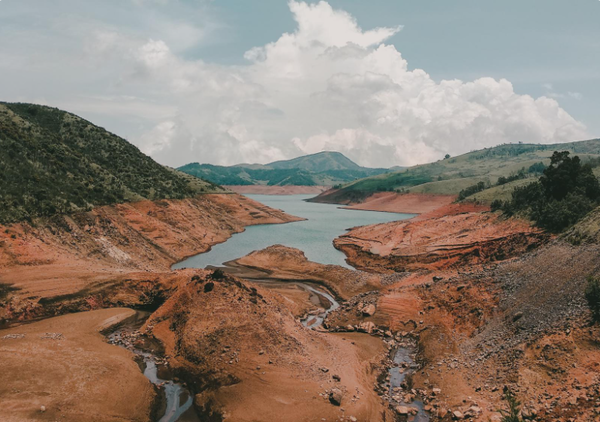가뭄 기간 단파복사, 강물의 수위·부피 감소·느린 유속과 연계해 강 온도 높여
지하수 투입·수로 음영·증발로 인한 냉각 효과가 고온 상쇄하기도

기후변화로 인해 지구온난화가 가속화 되고, 가뭄이 더 빈번하고 극심해질 것으로 예상됨에 따라, 새로운 연구는 물의 흐름 감소와 대기 온도의 상승이 어떻게 강의 온도를 높이는지 밝혀내, 수생 생물, 생태계 및 사회에 주요한 도전 과제를 제시했다.
강의 온도는 강의 모든 물리적, 화학적, 생물학적 과정을 조절하는 중요한 역할을 한다. 강의 온도는 물고기와 같이 자신의 체온을 조절할 수 없는 유기체에 특히 중요하며, 인간의 건강과 산업, 가정 및 여가와 같은 활동에도 중요하게 작용한다.
과학자들은 가뭄 동안 강 온도의 상승을 유도하는 세 가지 주요 메커니즘을 발견했다. 세가지 메커니즘은 △대기 에너지 투입 △물리적 서식지의 영향(강의 흐름을 조절하는 음영 및 강의 형태) △다양한 수원의 영향-지하수는 여름에 강의 온도를 낮추는 경향이 있다는 것이다.
버밍엄 대학교(University of Birmingham)가 주도하고 노팅엄 대학교(University of Nottingham)와 스코틀랜드 정부의 해양국(Marine Directorate)이 협력해 『Hydrological Processes』에 게재한 보고서에서는 덥고 건조한 기간 동안의 강렬한 단파복사가 강 온도를 높이는 가장 큰 요인이 될 수 있음을 강조했다.
단파복사는 가뭄 기간 동안 강물의 수위와 부피의 감소 및 느린 유속과 연계돼 물을 더 빠르게 데운다. 그러나 저자는 지하수 투입, 수로 음영 및 증발로 인한 냉각 효과가 특정 상황에서 고온을 상쇄할 수 있다고도 강조했다.
공동 저자인 데이비드 한나(David Hannah) 버밍엄 대학교의 수문학 교수이자 유네스코 수자원 과학 위원장은 “강 온도의 상승은 수생 생물에 중대하고 종종 해로운 영향을 미친다. 이는 개별 종과 전체 생태계 모두에 영향을 미칠 수 있다”고 말했다.
그는 “가뭄 조건은 종종 높은 대기 온도와 일치한다. 이러한 경향은 기후 변화와 함께 더욱 강렬하고 빈번해질 것이며, 강렬한 태양 복사와 낮고 느린 물의 흐름의 조합은 강 수온에 주요한 영향을 미친다”라고 덧붙였다.
또한 “그러나 강변에 식물 심기, 자연 수로 형태 재현 및 지하수 연결을 포함한 하천 복원 사업 등 관리 개입을 통해 가뭄 동안 강 온도 상승을 상쇄할 수 있다”라고 강조했다.
연구자들은 환경 및 생태적 이점을 제공하는 동시에 극한의 강 수온을 어떻게 상쇄할 수 있는지 고려하는 강 복원에 대한 총체적이고 유역 전반에 걸친 접근이 필요하다고 지적한다.
연구 저자들은 그들이 확인한 세 가지 메커니즘에서 프로세스가 어떻게 상호 작용하는지 조사하는 새로운 과학적 접근 방식을 요구하며, 이는 가뭄 동안 강 온도 상승이 발생할 가능성이 있는 장소와 시기를 예측하는 모델에 더 나은 정보를 제공하는 데 도움이 된다.
제임스 화이트(James White) 박사 버밍엄 대학교(University of Birmingham)의 수석 저자는 “우리의 연구는 가뭄 동안 강 온도 역학을 모델링하는 데 도움이 되는 중요한 미래 연구 질문을 강조하여 강 관리자가 완화 및 적응 전략을 통해 열 극단을 어떻게 더 잘 관리할 수 있는지 연구하는데 도움을 준다”라고 말했다.
[원문보기]
Drought conditions expose rivers to hotter water temperatures
Climate change and increasing drought will heat our rivers - creating major challenges for people, animals and plants.
As climate change warms the planet and droughts are anticipated to become more frequent and extreme, a new study reveals how reduced water flows and rising atmospheric temperatures are set to heat our rivers - creating major challenges for aquatic life, ecosystems, and society.
Water temperature is an important control for all the physical, chemical, and biological processes in rivers. It is particularly important for organisms that cannot regulate their own body temperature, such as fish. River temperature is important for human health and industrial, domestic, and recreational uses by people.
Scientists have identified three primary mechanisms that drive river water temperature increases during droughts: atmospheric energy inputs; physical habitat influences (shading and river channel shapes controlling flow); and the contributions of different water sources – groundwater tends to cool rivers in summer.
A review published in Hydrological Processes, led by University of Birmingham in collaboration with the University of Nottingham and the Scottish Government’s Marine Directorate, highlights that intense shortwave radiation during hot and dry periods is likely to be the biggest factor of high river water temperatures.
This combined with declining water levels and volumes, and slower flow velocities during droughts will warm up waters more quickly. However, the authors emphasise that cooling effects from groundwater inputs, channel shading and evaporation can offset high temperatures in certain circumstances.
Co-author David Hannah, Professor of Hydrology and UNESCO Chair in Water Sciences at the University of Birmingham, commented: “Rising river water temperatures can have significant and often detrimental implications for aquatic life, impacting both individual species and entire ecosystems.
“Drought conditions often coincide with high atmospheric temperatures and such trends will become more intense and frequent with climate change - with major implications for river water temperatures due to the combination of intense solar radiation and lower (and slower) water flows.
“However, certain management interventions such as riverside planting, and river restoration initiatives – including recreating natural channel forms and reconnecting groundwaters – could help to offset high thermal extremes during droughts if interventions are well targeted.”
The researchers note that more holistic, catchment-wide approaches to river restoration are required that consider how high river water temperature extremes can be offset while delivering other environmental and ecological benefits. The study authors call for new scientific approaches examining how the processes operating across the three mechanisms they have identified interact – helping to better inform models capable of estimating where and when high river thermal extremes are likely to occur during droughts.
Lead-author Dr James White, from the University of Birmingham, commented: “Our work highlights critical future research questions that will help us to better model river water temperature dynamics during droughts – helping river managers to work out how thermal extremes could be better managed through mitigation and adaptation strategies.”
[출처 = University of Birmingham(https://www.birmingham.ac.uk/news/2023/drought-conditions-expose-rivers-to-hotter-water-temperatures) /2023년 10월 18일]
[번역 = 박원희 기자]

